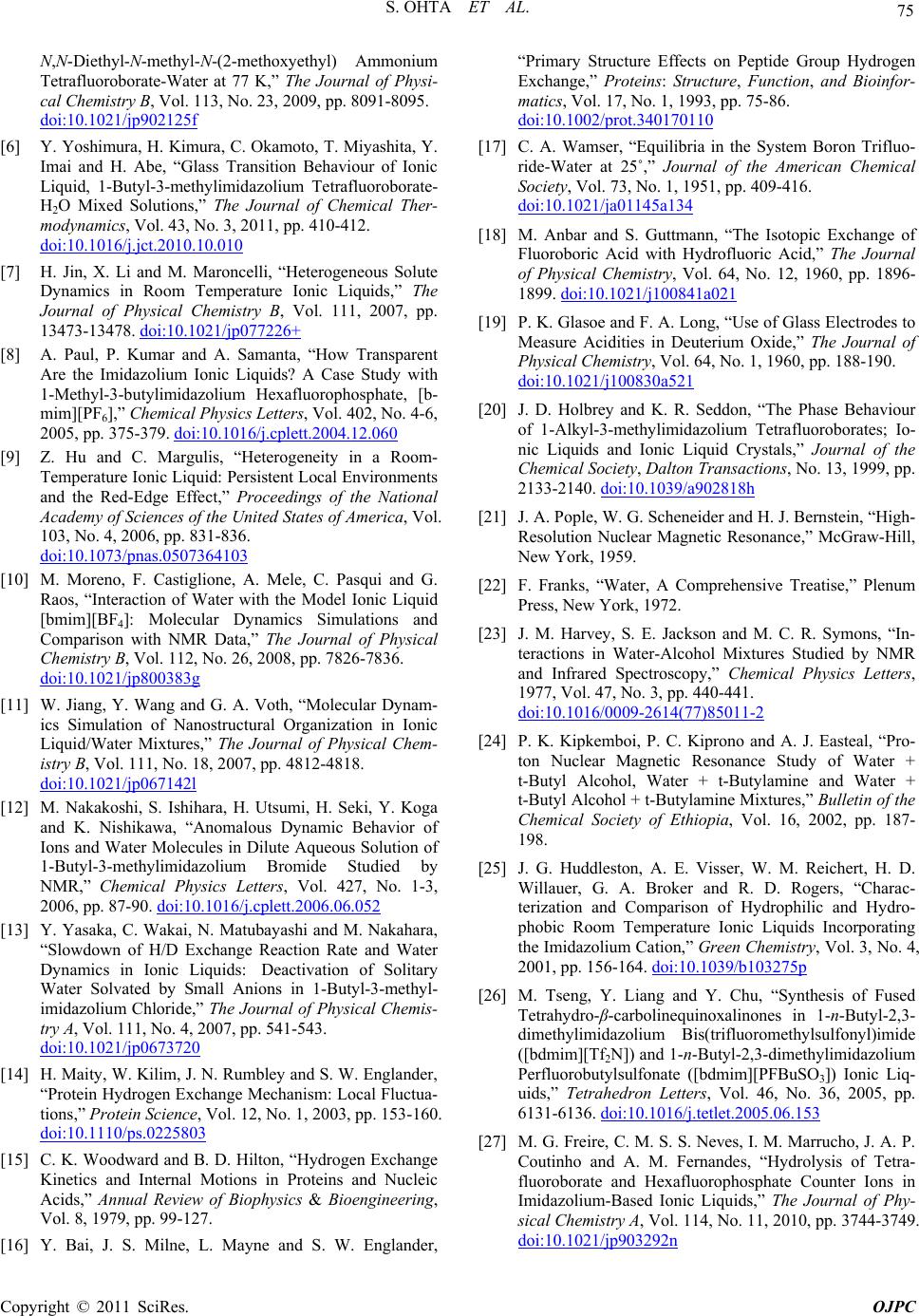
75
S. OHTA ET AL.
N,N-Diethyl-N-methyl-N-(2-methoxyethyl) Ammonium
Tetrafluoroborate-Water at 77 K,” The Journal of Physi-
cal Chemistry B, Vol. 113, No. 23, 2009, pp. 8091-8095.
doi:10.1021/jp902125f
[6] Y. Yoshimura, H. Kimura, C. Okamoto, T. Miyashita, Y.
Imai and H. Abe, “Glass Transition Behaviour of Ionic
Liquid, 1-Butyl-3-methylimidazolium Tetrafluoroborate-
H2O Mixed Solutions,” The Journal of Chemical Ther-
modynamics, Vol. 43, No. 3, 2011, pp. 410-412.
doi:10.1016/j.jct.2010.10.010
[7] H. Jin, X. Li and M. Maroncelli, “Heterogeneous Solute
Dynamics in Room Temperature Ionic Liquids,” The
Journal of Physical Chemistry B, Vol. 111, 2007, pp.
13473-13478. doi:10.1021/jp077226+
[8] A. Paul, P. Kumar and A. Samanta, “How Transparent
Are the Imidazolium Ionic Liquids? A Case Study with
1-Methyl-3-butylimidazolium Hexafluorophosphate, [b-
mim][PF6],” Chemical Physics Letters, Vol. 402, No. 4-6,
2005, pp. 375-379. doi:10.1016/j.cplett.2004.12.060
[9] Z. Hu and C. Margulis, “Heterogeneity in a Room-
Temperature Ionic Liquid: Persistent Local Environments
and the Red-Edge Effect,” Proceedings of the National
Academy of Sciences of the United States of America, Vol.
103, No. 4, 2006, pp. 831-836.
doi:10.1073/pnas.0507364103
[10] M. Moreno, F. Castiglione, A. Mele, C. Pasqui and G.
Raos, “Interaction of Water with the Model Ionic Liquid
[bmim][BF4]: Molecular Dynamics Simulations and
Comparison with NMR Data,” The Journal of Physical
Chemistry B, Vol. 112, No. 26, 2008, pp. 7826-7836.
doi:10.1021/jp800383g
[11] W. Jiang, Y. Wang and G. A. Voth, “Molecular Dynam-
ics Simulation of Nanostructural Organization in Ionic
Liquid/Water Mixtures,” The Journal of Physical Chem-
istry B, Vol. 111, No. 18, 2007, pp. 4812-4818.
doi:10.1021/jp067142l
[12] M. Nakakoshi, S. Ishihara, H. Utsumi, H. Seki, Y. Koga
and K. Nishikawa, “Anomalous Dynamic Behavior of
Ions and Water Molecules in Dilute Aqueous Solution of
1-Butyl-3-methylimidazolium Bromide Studied by
NMR,” Chemical Physics Letters, Vol. 427, No. 1-3,
2006, pp. 87-90. doi:10.1016/j.cplett.2006.06.052
[13] Y. Yasaka, C. Wakai, N. Matubayashi and M. Nakahara,
“Slowdown of H/D Exchange Reaction Rate and Water
Dynamics in Ionic Liquids: Deactivation of Solitary
Water Solvated by Small Anions in 1-Butyl-3-methyl-
imidazolium Chloride,” The Journal of Physical Chemis-
try A, Vol. 111, No. 4, 2007, pp. 541-543.
doi:10.1021/jp0673720
[14] H. Maity, W. Kilim, J. N. Rumbley and S. W. Englander,
“Protein Hydrogen Exchange Mechanism: Local Fluctua-
tions,” Protein Science, Vol. 12, No. 1, 2003, pp. 153-160.
doi:10.1110/ps.0225803
[15] C. K. Woodward and B. D. Hilton, “Hydrogen Exchange
Kinetics and Internal Motions in Proteins and Nucleic
Acids,” Annual Review of Biophysics & Bioengineering,
Vol. 8, 1979, pp. 99-127.
[16] Y. Bai, J. S. Milne, L. Mayne and S. W. Englander,
“Primary Structure Effects on Peptide Group Hydrogen
Exchange,” Proteins: Structure, Function, and Bioinfor-
matics, Vol. 17, No. 1, 1993, pp. 75-86.
doi:10.1002/prot.340170110
[17] C. A. Wamser, “Equilibria in the System Boron Trifluo-
ride-Water at 25˚,” Journal of the American Chemical
Society, Vol. 73, No. 1, 1951, pp. 409-416.
doi:10.1021/ja01145a134
[18] M. Anbar and S. Guttmann, “The Isotopic Exchange of
Fluoroboric Acid with Hydrofluoric Acid,” The Journal
of Physical Chemistry, Vol. 64, No. 12, 1960, pp. 1896-
1899. doi:10.1021/j100841a021
[19] P. K. Glasoe and F. A. Long, “Use of Glass Electrodes to
Measure Acidities in Deuterium Oxide,” The Journal of
Physical Chemistry, Vol. 64, No. 1, 1960, pp. 188-190.
doi:10.1021/j100830a521
[20] J. D. Holbrey and K. R. Seddon, “The Phase Behaviour
of 1-Alkyl-3-methylimidazolium Tetrafluoroborates; Io-
nic Liquids and Ionic Liquid Crystals,” Journal of the
Chemical Society, Dalton Transactions, No. 13, 1999, pp.
2133-2140. doi:10.1039/a902818h
[21] J. A. Pople, W. G. Scheneider and H. J. Bernstein, “High-
Resolution Nuclear Magnetic Resonance,” McGraw-Hill,
New York, 1959.
[22] F. Franks, “Water, A Comprehensive Treatise,” Plenum
Press, New York, 1972.
[23] J. M. Harvey, S. E. Jackson and M. C. R. Symons, “In-
teractions in Water-Alcohol Mixtures Studied by NMR
and Infrared Spectroscopy,” Chemical Physics Letters,
1977, Vol. 47, No. 3, pp. 440-441.
doi:10.1016/0009-2614(77)85011-2
[24] P. K. Kipkemboi, P. C. Kiprono and A. J. Easteal, “Pro-
ton Nuclear Magnetic Resonance Study of Water +
t-Butyl Alcohol, Water + t-Butylamine and Water +
t-Butyl Alcohol + t-Butylamine Mixtures,” Bulletin of the
Chemical Society of Ethiopia, Vol. 16, 2002, pp. 187-
198.
[25] J. G. Huddleston, A. E. Visser, W. M. Reichert, H. D.
Willauer, G. A. Broker and R. D. Rogers, “Charac-
terization and Comparison of Hydrophilic and Hydro-
phobic Room Temperature Ionic Liquids Incorporating
the Imidazolium Cation,” Green Chemistry, Vol. 3, No. 4,
2001, pp. 156-164. doi:10.1039/b103275p
[26] M. Tseng, Y. Liang and Y. Chu, “Synthesis of Fused
Tetrahydro-β-carbolinequinoxalinones in 1-n-Butyl-2,3-
dimethylimidazolium Bis(trifluoromethylsulfonyl)imide
([bdmim][Tf2N]) and 1-n-Butyl-2,3-dimethylimidazolium
Perfluorobutylsulfonate ([bdmim][PFBuSO3]) Ionic Liq-
uids,” Tetrahedron Letters, Vol. 46, No. 36, 2005, pp.
6131-6136. doi:10.1016/j.tetlet.2005.06.153
[27] M. G. Freire, C. M. S. S. Neves, I. M. Marrucho, J. A. P.
Coutinho and A. M. Fernandes, “Hydrolysis of Tetra-
fluoroborate and Hexafluorophosphate Counter Ions in
Imidazolium-Based Ionic Liquids,” The Journal of Phy-
sical Chemistry A, Vol. 114, No. 11, 2010, pp. 3744-3749.
doi:10.1021/jp903292n
Copyright © 2011 SciRes. OJPC